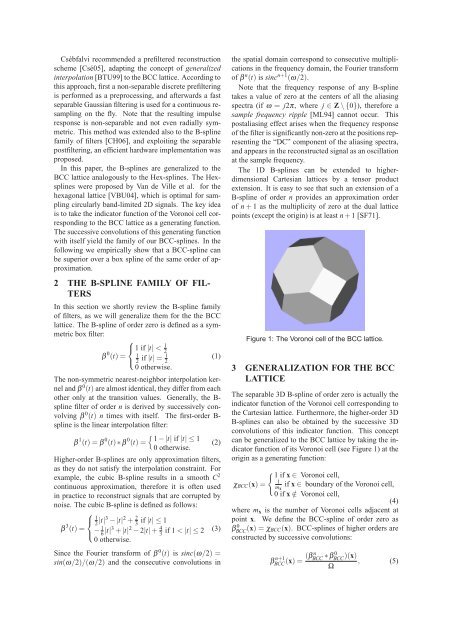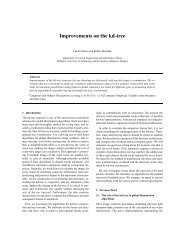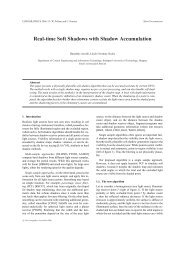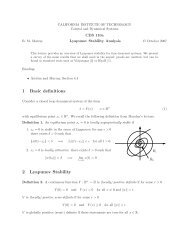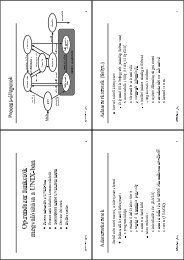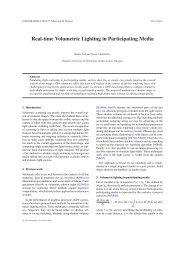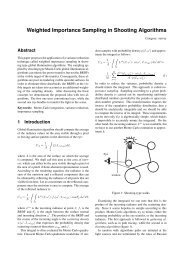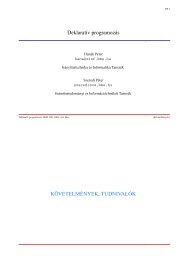BCC-Splines: Generalization of B-Splines for the Body-Centered ...
BCC-Splines: Generalization of B-Splines for the Body-Centered ...
BCC-Splines: Generalization of B-Splines for the Body-Centered ...
Create successful ePaper yourself
Turn your PDF publications into a flip-book with our unique Google optimized e-Paper software.
Csébfalvi recommended a prefiltered reconstruction<br />
scheme [Csé05], adapting <strong>the</strong> concept <strong>of</strong> generalized<br />
interpolation [BTU99] to <strong>the</strong> <strong>BCC</strong> lattice. According to<br />
this approach, first a non-separable discrete prefiltering<br />
is per<strong>for</strong>med as a preprocessing, and afterwards a fast<br />
separable Gaussian filtering is used <strong>for</strong> a continuous resampling<br />
on <strong>the</strong> fly. Note that <strong>the</strong> resulting impulse<br />
response is non-separable and not even radially symmetric.<br />
This method was extended also to <strong>the</strong> B-spline<br />
family <strong>of</strong> filters [CH06], and exploiting <strong>the</strong> separable<br />
postfiltering, an efficient hardware implementation was<br />
proposed.<br />
In this paper, <strong>the</strong> B-splines are generalized to <strong>the</strong><br />
<strong>BCC</strong> lattice analogously to <strong>the</strong> Hex-splines. The Hexsplines<br />
were proposed by Van de Ville et al. <strong>for</strong> <strong>the</strong><br />
hexagonal lattice [VBU04], which is optimal <strong>for</strong> sampling<br />
circularly band-limited 2D signals. The key idea<br />
is to take <strong>the</strong> indicator function <strong>of</strong> <strong>the</strong> Voronoi cell corresponding<br />
to <strong>the</strong> <strong>BCC</strong> lattice as a generating function.<br />
The successive convolutions <strong>of</strong> this generating function<br />
with itself yield <strong>the</strong> family <strong>of</strong> our <strong>BCC</strong>-splines. In <strong>the</strong><br />
following we empirically show that a <strong>BCC</strong>-spline can<br />
be superior over a box spline <strong>of</strong> <strong>the</strong> same order <strong>of</strong> approximation.<br />
2 THE B-SPLINE FAMILY OF FIL-<br />
TERS<br />
In this section we shortly review <strong>the</strong> B-spline family<br />
<strong>of</strong> filters, as we will generalize <strong>the</strong>m <strong>for</strong> <strong>the</strong> <strong>the</strong> <strong>BCC</strong><br />
lattice. The B-spline <strong>of</strong> order zero is defined as a symmetric<br />
box filter:<br />
⎧<br />
⎨1if|t| < 1<br />
β 0 2<br />
(t)= 1<br />
⎩ 2<br />
if |t| = 1 (1)<br />
2<br />
0 o<strong>the</strong>rwise.<br />
The non-symmetric nearest-neighbor interpolation kernel<br />
and β 0 (t) are almost identical, <strong>the</strong>y differ from each<br />
o<strong>the</strong>r only at <strong>the</strong> transition values. Generally, <strong>the</strong> B-<br />
spline filter <strong>of</strong> order n is derived by successively convolving<br />
β 0 (t) n times with itself. The first-order B-<br />
spline is <strong>the</strong> linear interpolation filter:<br />
{<br />
β 1 (t)=β 0 (t) ∗ β 0 (t)= 1 −|t| if |t|≤1<br />
(2)<br />
0 o<strong>the</strong>rwise.<br />
Higher-order B-splines are only approximation filters,<br />
as <strong>the</strong>y do not satisfy <strong>the</strong> interpolation constraint. For<br />
example, <strong>the</strong> cubic B-spline results in a smooth C 2<br />
continuous approximation, <strong>the</strong>re<strong>for</strong>e it is <strong>of</strong>ten used<br />
in practice to reconstruct signals that are corrupted by<br />
noise. The cubic B-spline is defined as follows:<br />
⎧<br />
⎨<br />
1<br />
β 3 2 |t|3 −|t| 2 + 2 3<br />
if |t|≤1<br />
(t)=<br />
⎩− 1 6 |t|3 + |t| 2 − 2|t| + 4 3<br />
if 1 < |t|≤2 (3)<br />
0 o<strong>the</strong>rwise.<br />
Since <strong>the</strong> Fourier trans<strong>for</strong>m <strong>of</strong> β 0 (t) is sinc(ω/2) =<br />
sin(ω/2)/(ω/2) and <strong>the</strong> consecutive convolutions in<br />
<strong>the</strong> spatial domain correspond to consecutive multiplications<br />
in <strong>the</strong> frequency domain, <strong>the</strong> Fourier trans<strong>for</strong>m<br />
<strong>of</strong> β n (t) is sinc n+1 (ω/2).<br />
Note that <strong>the</strong> frequency response <strong>of</strong> any B-spline<br />
takes a value <strong>of</strong> zero at <strong>the</strong> centers <strong>of</strong> all <strong>the</strong> aliasing<br />
spectra (if ω = j2π, where j ∈ Z \{0}), <strong>the</strong>re<strong>for</strong>e a<br />
sample frequency ripple [ML94] cannot occur. This<br />
postaliasing effect arises when <strong>the</strong> frequency response<br />
<strong>of</strong> <strong>the</strong> filter is significantly non-zero at <strong>the</strong> positions representing<br />
<strong>the</strong> “DC” component <strong>of</strong> <strong>the</strong> aliasing spectra,<br />
and appears in <strong>the</strong> reconstructed signal as an oscillation<br />
at <strong>the</strong> sample frequency.<br />
The 1D B-splines can be extended to higherdimensional<br />
Cartesian lattices by a tensor product<br />
extension. It is easy to see that such an extension <strong>of</strong> a<br />
B-spline <strong>of</strong> order n provides an approximation order<br />
<strong>of</strong> n + 1 as <strong>the</strong> multiplicity <strong>of</strong> zero at <strong>the</strong> dual lattice<br />
points (except <strong>the</strong> origin) is at least n + 1 [SF71].<br />
Figure 1: The Voronoi cell <strong>of</strong> <strong>the</strong> <strong>BCC</strong> lattice.<br />
3 GENERALIZATION FOR THE <strong>BCC</strong><br />
LATTICE<br />
The separable 3D B-spline <strong>of</strong> order zero is actually <strong>the</strong><br />
indicator function <strong>of</strong> <strong>the</strong> Voronoi cell corresponding to<br />
<strong>the</strong> Cartesian lattice. Fur<strong>the</strong>rmore, <strong>the</strong> higher-order 3D<br />
B-splines can also be obtained by <strong>the</strong> successive 3D<br />
convolutions <strong>of</strong> this indicator function. This concept<br />
can be generalized to <strong>the</strong> <strong>BCC</strong> lattice by taking <strong>the</strong> indicator<br />
function <strong>of</strong> its Voronoi cell (see Figure 1) at <strong>the</strong><br />
origin as a generating function:<br />
{ 1ifx ∈ Voronoi cell,<br />
1<br />
χ <strong>BCC</strong> (x)=<br />
m x<br />
if x ∈ boundary <strong>of</strong> <strong>the</strong> Voronoi cell,<br />
0ifx /∈ Voronoi cell,<br />
(4)<br />
where m x is <strong>the</strong> number <strong>of</strong> Voronoi cells adjacent at<br />
point x. We define <strong>the</strong> <strong>BCC</strong>-spline <strong>of</strong> order zero as<br />
β<strong>BCC</strong> 0 (x) =χ <strong>BCC</strong>(x). <strong>BCC</strong>-splines <strong>of</strong> higher orders are<br />
constructed by successive convolutions:<br />
n<br />
<strong>BCC</strong> (x)=(β <strong>BCC</strong> ∗ β <strong>BCC</strong> 0 )(x) , (5)<br />
Ω<br />
β n+1


